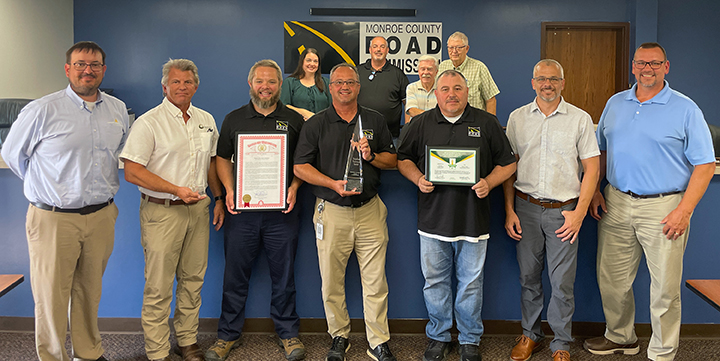Michigan travelers are now blessed with a national award-winning road
Every road has a story. And this story has all the classic components to make it one to share. First, there is a nearly insurmountable challenge, then there are elements of opportunity, creativity and teamwork which help solve the problem for the community in need. This is the story of Samaria Road in Monroe County, Michigan, a 2024 recipient of the Asphalt Pavement Alliance’s (APA) Perpetual Pavement by Conversion Award.
In the beginning
For the Samaria Road story, let’s rewind to 2013 when the Monroe County Road Commission (MCRC)was mired in continuous maintenance of a troublesome stretch of pavement that covered approximately ten miles across the southeasternmost county in Michigan. Samaria Road, in its 2013 form, was originally constructed back in the 1970s as an 8-inch, 22-foot-wide jointed plain concrete pavement. Tie-bars were installed every two feet to tie the two lanes together; however, no dowels were installed to help with load transfer from slab to slab. Time, traffic and climate took their toll on the pavement structure, leading to faulting and cracking, resulting in an uneven driving surface.
“These issues not only made travel difficult and unsafe for the public but also increased maintenance demands on the MCRC. Crews had to perform frequent patching andrepairs, which strained operational resources and diverted attention from other needed activities across the county,” said Dave Leach, Managing Director of the MCRC.
MCRC Senior Engineer Michael Smith added, “Not only did the frequent maintenance strain our budget, but it has also generated numerous complaints regarding ride quality from residents and commercial users.”
Opportunity and the challenge
Then in 2013, there was light. Public Act 51 in 2013 created the state of Michigan’s Roads and Risk Reserve Fund. Five million dollars from this reserve fund was earmarked for the reconstruction of Samaria Road. Even with 2013 costs and estimates, MCRC faced a dilemma in reconstructing the entire ten miles with the funding available. There were requirements for the finished pavement system as well. The driving surface needed widening for safety. Two twelve-foot lanes would better serve the residents, especially with an expected increase in truck traffic, with a smoother, safer pavement.
The final elevation of the pavement surface needed to be relatively close to the existing surface for the numerous structures and approaches across the ten miles. While under construction, the contractors would be required to allow access to the many residences and businesses across the length of the project, and it needed to be completed by the end of the year. Without a doubt, the concrete panels needed to be removed, and the county needed to build from the base up to the final surface with imported materials. Based on traditional remove and replace options, the engineering estimate exceeded the targeted budget and with no other funds available, MCRC faced a challenge.
Thinking outside the box
At the time, MCRC was working with industry partners and consultants to better understand how to incorporate the pavement recycling technologies into their network strategy. One of these technologies was full-depth reclamation (FDR). So an idea was presented to MCRC for consideration: “What if, after the concrete panels were removed, a contractor filled the slot with reclaimed asphalt pavement to a certain thickness. The RAP could then be mechanically blended with a portion of the good quality underlying aggregate base and stabilized with an asphalt emulsion, resulting in a flexible, homogeneous stabilized base layer. The county could then place two layers of HMA to attain maximum smoothness and keep nearly the same surface elevation of the pavement.”
The MCRC engineering team ran with the idea even though they had limited experience with the FDR process. MCRC consulted with industry partners, contractors and consultants familiar with the process and developed a conservative pavement design to meet the needs for expected future traffic, developed construction specifications and published a bid package that, based on engineer estimates, would be close to the total funds available for the reconstruction.
Execution of the project plan
June 9th, 2014, was a day with much anticipation. Multiple teams bid on the project, and the winning bid was awarded to a team led by Gerken Paving from Napoleon, Ohio. And to the delight and relief of MCRC, the winning bid was also below the five-million-dollar total. In addition to serving as the prime contractor, Gerken Paving would provide RAP and pave the two lifts of HMA. They teamed with Ten Mile Creek Excavating LLC, who completed the concrete pavement removal and FDR work. Asphalt Materials, Inc. was to perform the FDR mix design and supply the engineered emulsion for the FDR. The team developed a novel approach to crush and remove the existing concrete pavement and crafted a well-executed plan to complete the phased construction within the tight and narrow completion schedule. The following provides context on the process selected to reconstruct Samaria Road.
Important steps
The existing concrete was initially broken with a guillotine breaker, the MHBT Badger Breaker.
The concrete was then rubblized with an Iron Wolf RRS-01 Crusher attachment. The tie bars were removed.
The rubblized concrete was removed with a Wirtgen W220 milling machine and stockpiled for use on other projects. This was a significant indirect cost benefit to the MCRC, as the crushed concrete aggregate was used as aggregate to help maintain many of the gravel roadways across Monroe County.
Six inches of RAP were installed on the underlying aggregate base with an asphalt paver. The uniform thickness of the RAP layer improved the ride quality of the final stabilized product and ensuing HMA layers. The placed RAP also allowed for access to driveways and intersections after the concrete pavement removal.
Eight total inches (six inches of RAP and two inches of the underlying aggregate base) were stabilized with an FDR process using engineered asphalt emulsion at a rate of 2.7gallons per square yard. A GPS grading system was used during the FDR process, which enhanced overall pavement smoothness. The FDR material also carried local traffic before placement of the HMA intermediate layer.
Total of 3.5 inches of hot mix asphalt in two lifts; 2.0inches of an intermediate layer and a final surface HMA placed at 1.5 inches.
Realizing performance, recognizing engineering success
The transformation of Samaria Road had an immediate impact on Monroe County and its residents. The project received a smoothness award from the Asphalt Pavement Association of Michigan (APAM) and was recognized for excellence in FDR by the Asphalt Recycling and Reclaiming Association (ARRA).
Since 2014, the MCRC reports that Samaria Road has seen a 45% increase in traffic, reaching approximately 4,300 vehicles per day. In 2013, the commercial truck traffic was surprisingly around 13%; today it has reached 20%. Despite the increase in trucks and overall traffic, Samaria Road is still in excellent structural condition and has maintained excellent pavement smoothness for the driving public since its start. MCRC continues to maintain and preserve its investment.
Since 2021, MCRC has been phasing in a preservation asphalt overlay to sections as funding becomes available. With this overlay, MCRC has also been adding a 4-foot paved shoulder to enhance safety. Samaria Road was once a troublesome, never-ending maintenance nuisance. It is now a very manageable part of their pavement network with timely mill and overlay preservation cycles.
Samaria Road today
MCRC Highway Engineer Matthew Snell was encouraged to apply for the APA Perpetual Pavement by Conversion Award. According to the APA, the award honors agencies demonstrating outstanding design and construction practices, specifically in constructing new asphalt roads over existing roads. The projects must meet perpetual pavement requirements and are thoroughly reviewed, validated and selected by engineers from the National Center for Asphalt Technology (NCAT). The overall pavement structure of 3.5 inches and 8 inches of emulsion-stabilized FDR is expected structurally to last indefinitely.
MCRC will only need to maintain and periodically resurface the pavement, making it not only a very economical choice, but also a very sustainable design. Samaria Road was a clear candidate to receive this award.
On August 11, 2025, the prestigious crystal award was presented to the MCRC at its commissioners’ meeting. APA Coalition Partners, Asphalt Pavement Association of Michigan and Asphalt Institute representatives were in attendance to present the award. Members from the construction team, including Gerken Paving, Ten Mile Creek Excavating and Asphalt Materials, Inc., were present to recollect the challenges associated with the project and celebrate the county’s success with elected officials. The resounding themes heard throughout the ceremony included implementing innovative processes, sustainability, communication and teamwork to yield success.
To date, there have been only a few local agencies that have been recognized with the APA Perpetual by Conversion Award. What does this award mean to a local agency like the Monroe County Road Commission?
“The APA award is a great honor and a validation of the hard work and innovation the MCRC team has put into improving our infrastructure. It reflects our commitment to using cost-effective, sustainable solutions—like full depth reclamation—to deliver better roads for Monroe County residents. It’s also a testament to the strong partnerships we’ve built with engineers, contractors, and the community. Recognition like this boosts morale and motivates us to continue pursuing excellence in every project we undertake,” said Leach.
Perhaps Michael Smith said it best, “Receiving the Perpetual by Conversion Award from the Asphalt Pavement Alliance validates our agency’s decision to pursue innovative solutions for our infrastructure challenges. This recognition also means that we are not only maintaining roads but also constructing assets that will serve Monroe County residents for generations to come. Most importantly, it acknowledges the collaborative effort between our engineering team, Gerken Paving, and all the professionals who contributed to the project’s success. This award belongs to everyone who contributed to making Samaria Road the sustainable, high-performing corridor it is today.”
This story features many heroes—through teamwork, innovation and hard work—who delivered a durable, high-performing pavement. This community now proudly owns and maintains a nationally recognized flexible pavement for its ingenuity and performance, connecting the county and its people on the good Samaria Road.
Wielinski is an Asphalt Institute Regional Engineer based in Ohio.
Learn more about the awards at driveasphalt.org.














